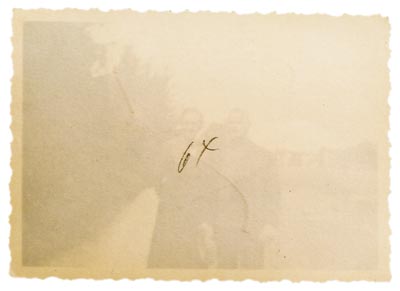|
BACKLIGHT 02 |
Kutschker, Thomas Germany / Saksa
REMEMBERED PICTURES
Kutschker focuses in his work on the ”other side” of photographs and thus shows us the ”bureaucratic” side of them. In this way he brings to our attention the way the pictures are handled, and he himself becomes a collector and an archivist. When usually only historians and archivist are interested in stamps or writings in order to identify a photograph as the work of some particular photographer, to determine where the picture was taken or to reconstruct the photographer or firm by the stamps, Kutchker also finds the backsides also aesthetically interesting. This aesthetical interest is directed towards the form of instrumental self-reflection of photographs, which is also typical of palimpsests. If the reading process is disturbed because the letters of the hidden text show trough, it becomes immediately clear that text is not an immaterial medium when its physical attributes come to the fore. Or when an exciting video film suddenly is interrupted only to show fragments of an previously recorded film, the medium itself becomes visible. Kutschker uses this palimpsest analogy as well. The photographs themselves tell their own media story, not the people imortalized on the front. Photography as an object comes to the fore. Burn marks, tears, creases and surface damages become visible. The viewer asks himself, for example, how the enormous number of scratchings made by a sharp object have appeared there, or how a tear, which runs straight through a little family standing in line, was born. The aesthetic value of the series is the impressive connection and comparison of the palimpsest and photography. Kutschker manages in his work to visualize the otherwise invisible ”other side of photographs”, the side of organizing and remembering. That which the theory of photography truly needs to spesialize on is immediately, precisely and impressively seen here: a photograph is more than a representation of the object, more than a picture of the photographee – that is, it is a medium and as a medium a part of collective culture of remembering, which would not be possible without photographs. Without the ”other side of photographs” the function of the pictures in the cultural memory could not be fulfilled and they would remain as individual shots and their order would fade irreversibly with the memory of the people who took them.
|
 |
|
Muistettuja Kuvia
Kutschker asettaa töissään tarkastelun keskipisteeksi kuvien “toisen puolen” ja tuo näin kuvien “byrokraattisen” puolen näkyville. Näin hän kiinnittää katseemme valokuvien käsittelytapaan, hänestä itsestään tulee keräilijä ja arkistonhoitaja. Kun yleensä pääasiassa historioitsijat ja arkistonhoitajat ovat kiinnostuneita leimoista tai kirjoituksista vaikkapa pystyäkseen kohdentamaan jonkin valokuvan tietyn valokuvaajan työksi, määritelläkseen otoksen paikan ja ajan taikka rekonstruoidakseen leimoista tekijän tai firman, Kutschkerille kääntöpuolet ovat myös esteettisesti kiinnostavia. Tämä esteettinen kiinnostus kohdistuu valokuvan välineellisen itsereflektion muotoon, joka on samalla tyypillistä palimpsesteille. Jos lukemisprosessi häiriintyy kun piilossa olevan tekstin kirjaimet kuultavat lävitse, käy heti selväksi, ettei teksti ole aineeton media, sillä sen aineellisuus astuu etualalle. Tai kun jännittävä videofilmi keskeytyy äkkiä ja näkyviin tulee pätkiä toisesta filmistä, jonka päälle uusi filmi on nauhoitettu, tulee itse mediasta näkyvä. Myös tätä palimpsesti –analogiaa Kutschker käyttää. Itse valokuvat kertovat omat mediatarinansa, eivät etupuolelle ikuistetut henkilöt. Itse valokuvaus objektina astuu etualalle. Näkyviin tulee palojälkiä, repeytymiä, taitoksia ja pinnan vaurioita. Katsoja kysyy itseltään esimerkiksi, mistä on peräisin suunnaton määrä terävällä esineellä aiheutettuja raapeutumia tai miten on syntynyt repeämä, joka kulkee aivan keskeltä rivissä seisovan pikkuperheen kuvan poikki. Kuvasarjan esteettinen ansio on palimpsesti-näkökulman ja valokuvauksen vakuuttava yhteensovittaminen. Kutschkerin onnistuu töissään visualisoida muutoin piilossa oleva “kuvien toinen puoli”, järjestelmän ja muistamisen puoli. Se, mihin valokuvausteoria tarvitsee runsaasti erikoistutkimusta, tulee tässä nopeasti, tarkasti ja vakuuttavasti esiin: kuva on enemmän kuin objektin representaatio, enemmän kuin kuvattavan kuva – nimittäin media ja mediana osa kollektiivista muistamiskulttuuria, joka ei olisi mahdollista ilman valokuvia. Ilman “kuvien toista puolta” kuvien funktio kulttuurillisessa muistissa ei voisi täyttyä, ne jäisivät yksityisiksi otoksiksi ja niiden järjestys kalpenisi vääjäämättä ottajansa muistin myötä. |
||